Do you wear a Kippah and/or Tzitzit?
On September 24, 1996 I asked my rabbinic colleagues… in particular, those who wear Kippot (and request/require the students in their congregations to wear Kippot when either studying or entering the synagogue), whether they wear Tzitzit as well, and if not, why.
My original question was not so much about Tzitzit or Kippah as it was about how we make our decisions.
First, I clarify from where I come.
Polity, not Piety
My background is not Reform, classical or otherwise. Nor is it Orthodox nor, Conservative (note: I list them in alphabetical order). In fact, I do not come to the rabbinate out of any of the “religious” (perhaps I should say “synagogue”) movements of our people. I come to the rabbinate from “polity” not “piety.”
My parents were Yiddishist Secularists and I grew up in Jewish Centers and the Labor/Socialist Zionist movement. Even so (or perhaps so!), I am the only one of the kids in the small Los Angeles Conservative congregation, where I celebrated becoming a Bar Mitzvah and Confirmation, who became a rabbi (and one of only one other—outside my family—who became professionally involved in Jewish life, though a very few others (I’ve tried to keep track) maintained high degrees of involvement). The rabbi of the congregation (B’nai Israel) (who I see once every three years or so — Paul Dubin, now (at the time this was first written, June 3, 1999) Executive Vice President of the Southern California Board of Rabbis) used to tell us that he wished he had a hundred congregants like us instead of what he had. Though we rarely went to services (my father felt they destroyed our Shabbes observance), we regularly made Shabbat dinner at home with candles, etc. and sang “Shabbes songs”. Looking back on it, I see that we sang songs “about” Shabbat, rather than singing Shabbat songs. Even so, we had a richer Jewish life than most of the people I knew. As we began our Erev Shabbat ritual, my father would say that we perform the actions and recite the words that identify ourselves with Jews throughout history and around the world… and “as the world turns toward darkness, it has been the practice of Jews to light candles in dark places.” Perhaps you could have called us “unidentifying Reconstructionists”. Since then I’ve coined the phrase “Closet Reconstructionists”. Actually, I often say:
99.44% of American Jews are Closet Reconstructionists
intellectual honesty, not “style”
I look for intellectual honesty, not “style”. Among other things, my father taught me how to think sociologically and anthropologically. I can appreciate that Tzitzit were probably part of the normal identifying dress of our biblical ancestors (see below). A description eventually became a prescription.… How do you know a fellow Israelite? Look for his fringes with a thread of Tekhelet! I am fascinated as to how the change has occurred from the Tzitzit to the Kippah.
When I graduated from high school (1964) I went to Israel on the Year Course of Young Judaea. We lived in the San Remo Hotel at the intersection of Strauss and ha-Nevi’im, not far from Me’ah She’arim.
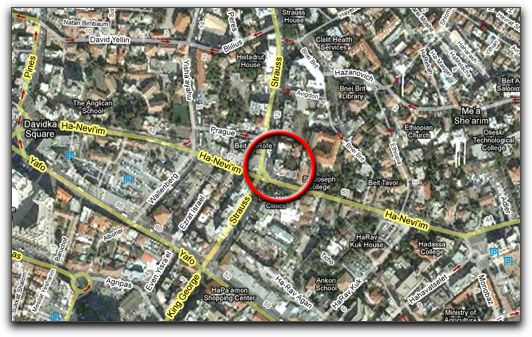
Intersection of Strauss & Ha-Nevi’im (Jerusalem)
On a street corner a block or so away from the “hotel” a young Dati woman (perhaps a couple years older than I) sat and crocheted Kippot.
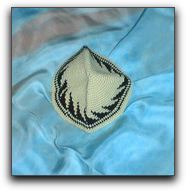
Me’ah She’arim Kippah
I bought one and began to wear it as if it were part of the “national costume” along with my Nimrod sandals and my blue shorts (Noam (now when this was first posted), periodically, wears wore this one). While living in Jerusalem, the girl with whom I had a hand-holding relationship crocheted another one for me which I wear at rare intervals.
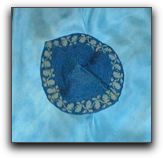
“Girlfriend’s” Kippah
In all respects I remained a secular Jew, even though I kept Kosher (not consciously or purposefully, that was what we were fed). I should add that in the winter time, growing up in Los Angeles, the males in my family wore berets. I had an old red one that I had with me in Israel and wore most of the time and even when I began to wear the Kippah. When I traveled out of Jerusalem on Shabbat, I wore the beret instead of the Kippah.
I wore the beret throughout the ’60s and into the ’70s, though I switched from red to black. My brother wore red.

Jay being left and Jewish
We were recognized around Los Angeles. For a short time I wore a Greek fisherman’s cap. (I appear that way in the Jewish Catalog.)
“unusual” Kippot as objects of Jewish costume
I have long had an interest in Kippot as objects of Jewish costume. I recall Ivy-League Kippot of the mid-’60s (plaid with a small belt buckle “in the back” –if you have one I want it–it belongs in a museum!). I remember hearing about one made of Levi’s denim sometime during the late ’60s (It even included the tag(!) does anyone have more information on this?). In the late ’70s, when I lived in New York City, I bought a beautifully hand-made, velvet-embroidered Kippah from a woman my age at a Jewish crafts fair sponsored by the UJA-Federation Campaign for which I then worked. (It has begun to wear out so I no longer use it; she was tragically mugged/killed a few years after I bought it.) In the late ’80s I bought what might be called a Rastafarian Kippah (rainbow-colored skull-hugging cotton from Guatemala and one big enough to stuff with a huge head of hair) which I wear on Parshat Noah and during the Joseph cycle.
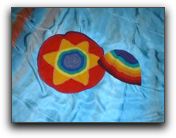
Rastafarian Kippot
In Israel (in Yafo) a few years ago I bought a “Muslim” Kippah made of white cotton thread which was actually made in China.
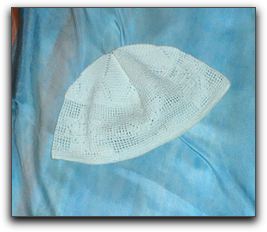
Muslim Kippah, Made in China, Purchased in Yafo
Now, I generally wear a “baseball” cap to keep the sun out of my eyes and my head warm. I look for a visor cap with no logo. I wore this on my last recent trip to Israel. In this way I do not have to carry a Kippah. I neither need to switch and put on a Kippah in those many places where it is expected/required, nor am I identified with that aspect of Israeli society with which I generally do not want to be identified.
past and future tallitot
When I became Bar Mitzvah I received the standard polyester Tallit common at the time.
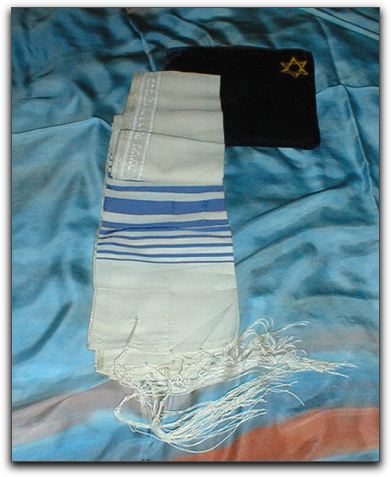
Bar Mitzvah Tallit
I wore it as the cantor of our Junior congregation.
Debbie and I were married under the silk Tallit that my grandfather had brought over from Russia, and probably never wore here in the States.
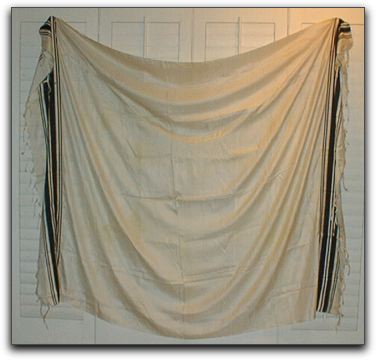
My Zayde’s Tallit
I started to wear my Zayde’s Tallit when I became the rabbi of a Reconstructionist congregation and they expected me to wear a Tallit (and Kippah of course). It began to show serious signs of wear at that time and I spoke with a member of the congregation who painted fabric for upholstery for a living about the feasibility of a painted-silk Tallit.
I described a Tallit that would enable me to wrap myself in earth and sky. As a good-bye present, nearly ten years ago, in 1988, they gave me an exquisite Tallit as I had described my desires. I wear wore it when I led services at my tiny congregation and, though I gave it to Noam for his Bar Mitzvah, more recently, when I attended services as well.
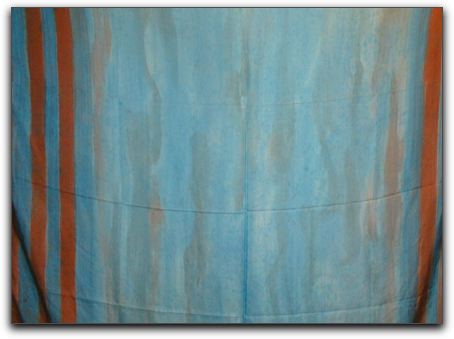
Bnai Keshet Tallit
Kippah and/or Tzitzit?
Currently, I do not wear a Kippah, but I do wear Tzitzit (inside).
Why? Intellectual honesty, I guess. I wouldn’t have asked the question I asked if I didn’t wear them.
But they’re beginning to “grow” on me.
Some of the reasons those of you who wear Kippot have offered (and I quote without correcting typos or changing orthography):…
One colleague suggests (and another seems to agree) that: “being visiblely Jewish is a new mitzvah.… Clearly, being ‘white’ in America used to mean not sticking out. I don’t want ‘white priviledge’… the kippah marks me as not white.”
I like this. It seems to relate to the ancient custom (and common in “traditional” societies) of having a “national costume.” However, neither of these colleagues explains why they wear a Kippah and (it seems) do not wear their Tzitzit showing. Which should serve the same purpose.
During the ’60s I wore not only the beret, but also for many years a lapel button (I collect them) of a yellow star on a black background.
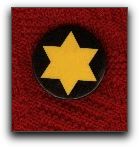
Yellow Star Lapel button
This clearly identified me as a Jew and raised consciousness. Until recently, all my work was within the Jewish community. Everyone with whom I interacted knew I was a Jew: we all were. In that context, a Kippah meant nothing. For the past seven years Since 1988 I’ve worked in a small company, a non-Jewish, business environment. Everyone knows I’m a Jew and after a while, they find out that I’m a rabbi. Now, that subtle awareness seems sufficient. I need no special markers.
I saved a note from another colleague a number of months ago: “Ganzfried, who wrote the Kitsur, was a founder of Orthodoxy, in Hungary. He did the book not so much to shorten the classic but to crystalize and set in concrete what he believed to be the right way to go.… It was Ganzfried, not Karo or Mapah who insisted on head coverings at all times. Karo mentions that certain groups have the minhag of praying with heads covered. We do well to remember that Orthodoxy is the reaction to Reform, whch began some 20 years or so earlier.”
I have tried to approach Tzitzit afresh (whether hidden or displayed).
What is the meta for?
None of the respondents have written of the metaphor of Kippah, only a “new” Mitzvah. (Yes, I know of at least one metaphor: something “beyond” me.) So, I ask myself: “Do I respond to a Mitzvah of Tzitzit? And if not the Mitzvah, then, what is the metaphor of Tzitzit?”
Eric Simon (writing in his weekly drash on the l.torah (Liberal Torah) list identifies Tzitzit in a manner similar to the Kippah):
Torah even suggests wearing the proverbial “string on our finger” to remind ourselves (actually, strings from a garment, Tzitzit) to follow the commandments.
Interestingly this is also how R. Mordechai Kaplan is reported to have interpreted the Tzitzit: he would proudly display his Tallit Katan with a purple thread on each of the four corners. He would then explain that it was meant to remind the wearer of the sovereignty of God and of the demands of the Mitzvot which is to say that our own will is not final but should be subservient to higher principles. He would also say that it served to remind him of the primary principle of divinity which is the assumption that there is enough in the world to meet our need but not our greed for power and pleasure. To which someone commented: “If you look at the Shemah on Tzitzit you will see how this statement is an interpretation.”
This is basically what Kippah wearers suggest as their metaphor. So again, why not Tzitzit?
Our contemporary midrashist Arthur Waskow suggests:
new “tzitzit” between the different traditions, fringes rather than fences.… But I do think there is a permeable-membrane boundary here, not a black-white on/off rigid one. For me the metaphor of tzitzit is relevant here — just as between individuals we say that our boundaries are fuzzy fringes, not on/off walls or fences, so nowadays between different communities and traditions the boundaries are fuzzy and fringe-like, not like ghetto walls. Given that, for me the question is how to tie CONSCIOUS fringes, not helter-skelter fringes. The tzitzit are CONSCIOUS and Jewishly self-aware fringes, rather than a surrender to helter-skelter.
On another list a discussion of Tekhelet in the Tzitzit gave rise to some interesting ideas. Some Israelis have formed a non profit organization for the production of real Tekhelet Tzitzit.
So, when a particular colleague (who wears a Kippah) says: “they don’t enhance my spirituality” I have to ask:
What is this Jewish value: “spirituality”?
An older colleague (who I think wears neither a Kippah nor Tzitzit) has a more technical problem with the previous colleague’s response of being patoor. He suggests that unless “he [the previous colleague, that is, or actually, we] wears something round, all garments have corners, so technically he is obligated.”
To which our list’s moderator responded:
Perhaps, then, the commandment tells us what to do with tassles we already wear. We are then faced with a decision: what do we do when we no longer wear tassles. To my mind, this is roughly analogous to commandments that pertain to slaves. We have no slaves, and so ignore those commandments. We have no tassles, and so perhaps we should ignore this commandment, too.
Yet we no longer wear hats either and our moderator did not indicate that he does or does not wear a Kippah, but he does say: “Then again, I still wear a tallit at shul.…”
An interesting parallel to my question has arisen on the liberal Judaism mailing list. There the question is whether or not men and women each must wear a Tallit when they have an Aliyah to the Torah. But even there, the presumption is that one wears a Kippah when in the synagogue and dons a Tallit for the special liturgical moment.
To repeat the question:
How do we make the decisions of what is an appropriate Mitzvah?
A related question arose recently on my favorite list: how do we pronounce the vowel “Tzayray”? Some have decided to determine the pronunciation based on a sociological choice: Israelis on the street pronounce it thus. Others have opted for a “purist” pronunciation. I can understand not pronouncing the Thav or the soft Jimel (these seem to have been lost to us long ago). I struggle to teach my students that Hebrew does not have any “silent” consonants. We may have difficulty hearing and pronouncing the difference between Alef and Ayin, but that doesn’t mean there isn’t one. We can also “give up” on the Kamatz Katan. And I have heard rabbis who, once they learn how to pronounce a Het begin to pronounce Hehs as though they were Hets. This is “sociologically based” choosing.
Some of us decide whether or not to officiate at intermarriages or same-sex commitment ceremonies marriages based on what it might do (or not do) to the Jewish people or the specific individuals involved. Once again, this is sociological. Others of us make this decision based on a reading of our inherited texts. This is (for want of a better word) theological. I wouldn’t be surprised if some of us make our decisions sometimes sociologically and at other times theologically.
So, why do I wear Tzitzit? Or, why do I wear Tzitzit?
In no particular order:
- Growing up in a Yiddishist Secularist home in Los Angeles, California, what I considered then to be the “farthest reaches of the diaspora”, I was aware of living on the edge (of the continent)…

The Venice Fine Arts Squad (Terry Schoon- hoven and Victor Henderson), “The Isle of California”, mural at Butler and Santa Monica Blvd., West Los Angeles, 1971.
…and even sometimes, beyond the fringe.
- I enjoy the physical reminder of that “edginess”.
- Shortly after I was born, our mother grew her hair long and began wearing it in a braided crown. She kept that hair style the rest of her life. It is almost as though she was the solid, seemingly unchanging, center around which all the rest of us were enabled to flip around freely.
- Our father would often say that learning is like creating a fishing net or a spider’s web. The more you weave into it the more it is capable of catching. The Tzitzit remind me of how much still remains for me to weave in. [added 2009–06-05T11:35:17+00:00]
- Change is a constant, yet most of us do not experience it. We live buffered. Most change happens at the edge and along the fringe.
- I have been active in “outreach” work since before the term was common in the Jewish community. At the time (late ’60s early ’70s) we considered it simply “community organizing”. But, when you are organizing a community or reaching out, it is, almost by definition to those who are on, or beyond, the edges/fringes.
- As we trust scouts to explore areas where the vast majority of us will not go, I volunteer. The fringes I wear remind me that I an still connected to the community that “sent” me.
- I am (as many who know me well will report) willing to take chances and taste new and untested experiences, to see how I can weave these into who I am and can become. (My father would wear a lapel button with the text: “I’m a scientist. Let’s experiment.”)
- I like the idea of taking something very old and making it new. The fact that the ancient Egyptians knew that Semitic peoples wore fringed garments suggests that this has been a way of general Semitic self-identification of many thousands of years. (By the way, it is interesting to note that the ancient Egyptians divided the world among 4 peoples while the ancient Jews recognized only 3 (cf. Genesis 9:18–19 (English and Hebrew).

Four peoples of the world:a Libyan, a Nubian, an Asiatic (wearing fringes), and an Egyptian. An artistic rendering, based on a mural from the tomb of Seti I.
Throughout 2006 I gave myself a challenge to write a simile each morning as I started my day. On June 27, I wrote this one:
your marriage is like Tzitzit, a tying together the loose threads of your lives.
Here, at davka.org, despite everything, I continue to explore, experiment and reach out to weave a Web of associations.
Some links to Tallit and Tzitzit of interest (most of these pages no longer exist):
- [rotten] Reform Jews discuss the meaning of Tzitzit and more (written by “lay people”)
- [rotten]The Laws of Tzitzit from The Hypertext Halacha
Copyright © 1995 by Project Genesis, Inc., the Jewish Learning Network. - [rotten]Rabbi Jack Moline’s Tallit Kavvanah
- [rotten]Meditation before putting on Talit from Sefer Yetzira posted by Michael Graffam (a “ben Noah”)
- Rabbi Amy Scheinerman’s discussion of Tallit and Tzitzit
- [rotten]On the meaning of Tzitzit among the Breslov Chassidim
- The Beged Ivri (“Hebrew Clothing”) Guide on How to Tie Tzitzith
- On Tekhelet the sky-blue (or royal-purple) thread in the Tzitzit
- [rotten]More about Tekhelet
- [rotten]Beth Kellman textile artist with custom-made Tallitot
- Avigail’s Tallit was made for her by Nancy Katz
- From the Wikipedia (which did not exist when this page was first published):

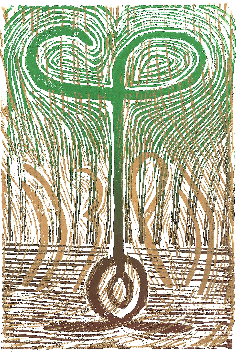
Great redesign of the website. Much more easily readable and accessible. Thanks for announcing its new incarnation on HUCALUM. I look forward to returning again and again.